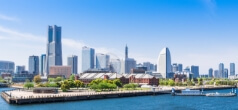Ginza/Nihonbashi/Otemachi

Ginza

Ginza has the most wealthy and high-class sound in its name, and the experience you get in Ginza single-handedly lives up to its reputation. This Tokyo’s most iconic shopping area boasts anything fancy. You will find all the leading brand names in fashion and cosmetics. Hermes, Tiffany, Christian Dior, Louis Vuitton, Chanel, Cartier, you name it, they have a presence here. There are also many five-star hotels, gorgeous department stores aimed at more mature crowds, and even art galleries. And such features draw tourists from all over the world.
The wealth is reflected in its land value as well. Just for reference, one square meter of Land in the centre of this district is worth over 10 million yen.
But when it comes to real estate, it is a predominantly commercial area, and there is not many residential buildings. You may be able to find some very old local houses or small studio apartments, but still they are very rare.

If you google "Ginza", the clock tower of the Ginza Wako building would be the first image that comes up. This symbol of Ginza, built in 1932, is centrally located and it offers luxury goods like jewelry and cosmetics.

The Mitsukoshi department store, and the Matsuya department store are some of the other symbolic and historic buildings in the area. But Ginza has also been redeveloped to enhance its sophistication even more.

The Tokyu Plaza Ginza, opened in 2016, is a shopping complex that features many dining options and tax free shopping for foreign tourists.

Ginza Six is another shopping complex opened in 2017 that offers a large bookshop specialised in art publications, and a stunning rooftop garden with views over the city.
ACCESS
- Ginza station on “Hibiya” line, “Ginza” line, “Marunouchi” line
- Yurakucho station on "JR" line, “Yurakucho” line.
- Ginza 1-chome station on "Yurakucho" line
- Higashi Ginza station on “Hbiya” line, “Toei Asakusa” line
Nihonbashi

Nihonbashi is the definition of commercial prosperity in Japan, well known to be home to the Bank of Japan and the Japan Mint.
The district is the centre of the city both geographically and economically, boasting many shops with centuries-long histories still in operation today.
Nihonbashi ("Japan Bridge"), after which the district was named, connects the two sides of Nihonbashi River. This grand bridge used to be wooden and was reconstructed in stone back in Meiji period. But it still retains Japanese traditional looks attracting many tourists.

On the north side of the bridge, the Japan's oldest department store, Mitsukoshi, has a presence since 1673 in front of Mitsukoshimae Station.

But this area is not just about historic centuries-years-old buildings. There have also been some new additions to the area as well. One of which is the Coredo Muromachi made up of three skyscrapers, which offer craft shops, indigenous foods from across Japan, quality restaurants and cafes.
As you might have already assumed, this area is not so suitable to live due to the shortage of residential apartments. But there are still luxury high-rises, smaller studio/one bedroom apartments perfect for those who work for a company in the Nihonbashi skyscrapers.
ACCESS
- Nihonbashi station on “Tozai” line
- Mitsukoshimae station on "Ginza" line, “Hanzomon” line.
- Kyobashi station on "Ginza" line
- Kayabasho station on “Tozai” line
- Hatchobori station on “Hibiya” line
Otemachi

Otemachi is located in between Tokyo station (Marunouchi district) and the Imperial Palace. Otemachi Station is the biggest subway station that serves 5 major subway lines, Marunouchi Line, Chiyoda Line, Tozai Line and Hanzomon Line on the Tokyo Metro, and the Toei Mita Line.
At first glance, you may think the area is just down to suit-wearers and office towers in which many large domestic and international companies are headquartered. But Otemachi has a lot to offer in terms of commerce and entertainment as well.

Walk outside from the east exit of Tokyo Station, you will be drawn to the sleek lines of the KITTE building, designed by 2020 Tokyo Olympic Stadium architect Kengo Kuma. KITTE complex boasts loads of shopping and dining establishments, and a beautiful rooftop garden free to enter.

If you crave for a larger green space to avoid the crowds, there is the Outer Gardens of the Imperial Palace just a 5 minute walk from the chuo exit of Tokyo Station. It is a perfect spot for a scenic stroll along the palace’s moat.
There are some good hotel accommodations for business travelers, but it is not easy to find residential apartments for a longer term stay in this area.
ACCESS
- Tokyo station on “JR” line, “Marunouchi” line
- Otemachi station on "Chiyoda" line, “Hanzomon” line, “Mita” line, “Tozai” line
- Hibiya station on "Hibiya" line, “Chiyoda” line, “Mita” line
- Nijyubashi station on “Chiyoda” line
New Listings in Ginza/Nihonbashi/Otemachi
For Rent
-

DUO FLATS NIHOMBASHI SUITENGU
JPY 153,000~385,000
Studio~2BR
25.18~56m²
Hanzomon Line Suitengumae Sta. (3 min)
-

ROYGENT GINZA
JPY 207,000~500,000
Studio~2BR
34.92~76m²
Oedo Line Tsukijishijo Sta. (5 min)
-

THE PARK HABIO NIHONBASHI MITSUKOSHIMAE
JPY 161,000~420,000
Studio~2BR
27.86~61m²
Hibiya Line Ningyocho Sta. (5 min)











